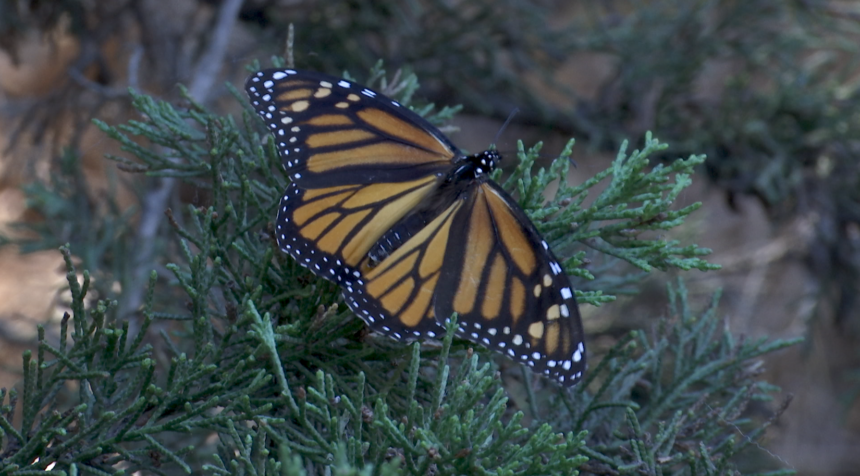Peak of monarch butterfly season now happening at Pismo State Park

PISMO BEACH, Calif. – Thousands of monarch butterflies have returned to Pismo State Park marking their annual return to a grove of eucalyptus trees located on the coast along Highway 1.
"We're in the heart of monarch season," said Michelle Claassen, State Park Interpreter I. "We always say that peak of the season is between Thanksgiving and New Year's or right there, there is a peak count take in on the Thanksgiving holiday and yeah, now it's time to visit."
Claassen noted a meticulous count of the butterflies just took place, indicating just how many monarchs are currently on site.
"Our current number is just above 16,000," said Claassen. "The Western monarch butterfly is on a massive decline, so that's sort of a low number even compared to last year when we had around 25,000 monarch butterflies. We're still not certain as to why that is."
Claassen noted that despite the sheer number of butterflies and their inherent nature to fly around, the count is extremely accurate.
"We do count by hand early in the morning when none are flying around," said Claassen. "They're still in their clusters. We go tree by tree, cluster by cluster, and you take one cluster and there's about three or four of us looking at the same cluster with binoculars and you extrapolate taking a group of like ten or 20, depending on the size of the cluster, maybe even counting by 50 is going around and then counting for the density of it."
With the peak of monarch season now in full effect, the grove is drawing droves of visitors to the site daily.
"It fills my soul," said Cathy Atkins, who said she traveled to Pismo Beach from the suburbs of Chicago especially to visit this grove. "It's so much joy. It's very serene here. Like I said, it's all encompassing with. With the smell of the eucalyptus, the site of the monarch. It's. It fills my soul."
Visitors to the grove are treated to several clusters of monarchs that are gathered up in the trees, which as first sight, resemble something far more different.
"It's fun because you walk in and it just looks like eucalyptus trees," said Brenda Baker, visiting from Wyoming. "As you get close, you see these dead leaves, but they're not dead leaves. They're hundreds and thousands of butterflies. I couldn't believe it when the docent said there are 16,000 butterflies here. Unbelievable!"
During busy periods of time, especially weekends, docents are on site to help answer questions and provide valuable information to visitors.
"They are really friendly, professional, and so well-educated," said Lisa Montgomery from Palm Springs. "They shared so much information with us and helped us understand how really incredible this whole process is, and the journey of the monarch, and to hear their lifespan, and how this all came about, and what a rare place this is because there aren't many places like this in the United States, so I'm really happy to be here to be a part of it."
The monarchs are a familiar sight in Pismo Beach this time of year, returning to this same grove of trees for many decades.
"They need a very specific environment for their overwintering site," said Claassen. "This site provides that. You'll the eucalyptus trees, their height and canopy of leaves is just perfect for them, providing protection from wind and rain, great opportunities to cluster here, being close to the ocean. Also, the microclimate, it's not too hot, not too cold, and the marine layer that comes in the fog, they need that for the the dew to drink. All those factors just make this the perfect place and they know it. They feel safe here, and so that's why they keep coming year after year."
The numbers of butterflies has greatly fluctuated through the years. According to date provided by California State Parks, the high count was In 1990, when the number of monarchs reached 230,000. A low of just 200 came in 2020 due to severe drought conditions.
Over the past three years, the number of butterflies has rebounded with about 21,000 in 2021, 24,000 last year and the 16,000 this year.
"This is the perfect time," said Claassen. "It's a gradual taper when they start to leave, usually late February or late January, early February, they will start to taper off, so really right now is the best time, early December, but about to mid-January, you'll see good numbers here, and when you're here and you're seeing these monarch butterflies, it is truly special because they have made such a long journey to get here. And now they're just here relaxing and resting for the rest of their life."
The grove is open seven days a week from sunrise to sunset and is free to enter. Closures due to inclement weather may take place as conditions warrant.
For more information on the Pismo State Beach Monarch Butterfly Grove, click here.
